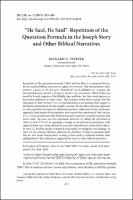Please use this identifier to cite or link to this item:
https://hdl.handle.net/20.500.12202/6631| Title: | “He Said, He Said”: Repetition of the Quotation Formula in the Joseph Story and Other Biblical Narratives. |
| Authors: | Steiner, Richard C. |
| Keywords: | repetition of quotation formula ויאמר synchronic approach biblical exegesis biblical narrative |
| Issue Date: | 2019 |
| Publisher: | Society of Biblical Literature |
| Citation: | Steiner, Richard C. (2019). “He Said, He Said”: Repetition of the Quotation Formula in the Joseph Story and Other Biblical Narratives. Journal of Biblical Literature, 138(3), 473-495. |
| Series/Report no.: | Journal of Biblical Literature;138(3) |
| Abstract: | Repetition of the quotation formula ( ויאמר and the like) is a common literary device used in biblical narrative to signal discontinuity. The discontinuity often involves a pause in the discourse. Instead of—or in addition to—a pause, the discontinuity may involve a change in the discourse parameters. Most of this was noted by Jewish exegetes of the Middle Ages and later, but their work appears to have been unknown to early critics. The writings of the latter assume that the repetition of ויאמר in Gen 37:21–22 and elsewhere is an anomaly that requires a diachronic explanation. It took roughly a century for the old synchronic approach to such repetition to regain its dominant position. Adherents of the synchronic approach, both medieval and modern, have viewed the repetition of ויאמר in Gen 37:21–22 as an indication that Reuben paused to wait for a positive response that never came. The facts are best explained, however, by taking the repetition of ויאמר in Gen 37:21–22 as signaling a change in the discourse parameters, with regard to both type (from internal to external) and addressee (from self to other). In verse 21, Reuben speaks to himself in his mind, revealing his true feelings. In verse 22, by contrast, Reuben addresses his brothers, trying to persuade them that he, too, wants Joseph dead, as long as that result is achieved without their spilling blood. This solution is supported by texts in other biblical narratives. |
| Description: | Research article, peer-reviewed / Open access |
| URI: | http://dx.doi.org/10.15699/jbl.1383.2019.644838 https://hdl.handle.net/20.500.12202/6631 |
| ISSN: | 0021-9231 (print) 1934-3876 (online) |
| Appears in Collections: | Bernard Revel Graduate School of Jewish Studies (BRGS): Faculty Publications |
Files in This Item:
| File | Description | Size | Format | |
|---|---|---|---|---|
| Steiner JBL 2019 HeSaidFinalProofs.pdf | 604.99 kB | Adobe PDF |  View/Open |
This item is licensed under a Creative Commons License

